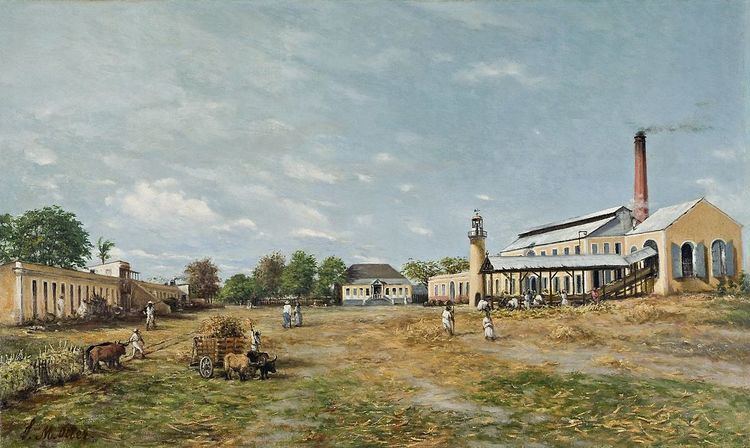 | ||
With the country's ethnically diverse background, Puerto Rican art reflects many diverse influences.
Contents
Santos
Puerto Rican art includes an especially beloved form of folk art, evolved from the Spanish church's use of sculptures to convert indigenous Puerto Ricans to Christianity. Santos, meaning "saints" in Spanish, depict figures of saints and other religious icons. Families continue to pass this centuries-old craft down from generation to generation. The artisans, called santeros, create santos from native wood, clay, and stone. After shaping simple effigies, they often finish by painting them in vivid colors. Santos vary in size, with the smallest examples around eight inches tall and the largest about twenty inches tall. Traditionally, santos were seen as messengers between the earth and Heaven. As such, they occupied a special place on household altars, where people prayed to them, asked for help, or tried to summon their protection.
Caretas
Caretas are also very popular. Caretas are masks worn during carnivals. Similar masks signifying evil spirits were used in both Spain and Africa, though for different purposes. The Spanish used their masks to frighten lapsed Christians into returning to the church, while tribal Africans used them as protection from the evil spirits they represented. Puerto Rican caretas always bear at least several horns and fangs, true to their historic origins. While they are usually constructed of papier-mâché, coconut shells and fine metal screening are sometimes used as well. Though red and black were originally the typical colors for caretas, their palette has expanded to include a wide variety of bright hues and patterns.
Visual arts
Perhaps the strongest Spanish influenced on Puerto Rican arts was in painting. During the colonial period, native-born painters emulated classic European styles. The first of these artists to gain international acclaim, José Campeche, learned techniques from both his father, who was also a painter, and exiled Spanish artist Luis Paret. His work concentrated on religious themes and portraits of important citizens in Spanish Rococo style. Still regarded as the most important 18th century painter in the Americas, Campeche is also credited with creating Puerto Rican national painting.
In the 19th century, Francisco Oller followed in Campeche's footsteps. He studied in both Madrid and Paris, which greatly influenced his work. Although his paintings often show an Impressionist or Realist style, he altered his style with each piece to suit the subject matter. Landscapes, portraits, and still lifes were all among his works. After moving back to Puerto Rico in 1884, Oller became interested in portraying Puerto Rican subject matter. He also founded an art academy and wrote a book on drawing and painting the natural world.
By the end of the 20th century, painting no longer defined Puerto Rican art as it once had. "A group of contemporary artists who came into maturity in the 1990's broke away from nationalistic agendas so crucial to previous generations of artists from Puerto Rico," according to curator Silvia Karman Cubiña. "Instead their works are informed by more personal issues, as well as broader topics such as gender, consumerism, world history, film and literature." The importance of artists such as Allora & Calzadilla, Rosado Seijo, and Arnaldo Morales was "their social dimension and the potential for interaction with others." For others such as Manuel Acevedo, Javier Cambre, Nayda Collazo-Llorens, and Carlos Rivera Villafañe, it was their multi-media and site-specific installations that expanded on the "nontraditional modes begun in earlier generations, by artists such as Rafael Ferrer and Rafael Montañez Ortiz, and then Antonio Martorell, José Morales, Pepón Osorio. and Beatriz Santiago Muñoz.
